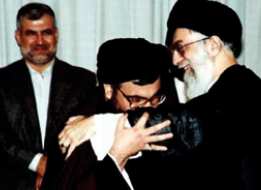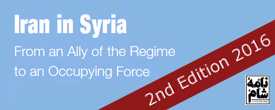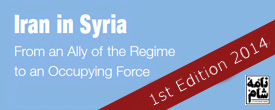Conclusion of Chapter I
Chapter I has shown that Bashar al-Assad’s regime would not have been able on its own to suppress the mass popular protests that erupted in Syria in March 2011 and the subsequent armed opposition across the country. It has shown that the Syrian regime would not have survived long without the unlimited, full-scale military support provided to it by the Iranian regime. In the words of a Hezbollah Lebanon fighter quoted by the Time magazine in November 2013, “If we don’t defend the Syrian regime, it would fall within two hours.”361
The chapter examined in detail the Iranian regime’s military involvement in the war in Syria, tracking its gradual increase over the period March 2011 – August 2014, an increase that would culminate in a de facto occupation of the country, as the next chapter will argue. From Sepah Pasdaran commanders providing strategic and tactical ‘advice’ to Syrian regime forces, through providing weapons and fighters, to creating, arming and directing various local and foreign militias that gradually assumed a leading role in the war.
This leading Iranian role is likely to continue after Bashar al-Assad falls if Hezbollah Lebanon and other Sepah Pasdaran-controlled militias remain stationed in Syria. Indeed, many analysts have argued that the Iranian regime’s strategy in Syria goes beyond saving Bashar al-Assad’s regime and includes preparations for a post-Assad era in which Iranian-controlled militias still exert influence on the ground and serve the Iranian regime’s interests.362 These interests include, first and foremost, securing Iranian arms shipments to Hezbollah in Lebanon.
Apart from the political consequences and implications, there are also important legal consequences for the Iranian regime’s involvement in the war in Syria: its complicity in various war crimes and crimes against humanity committed in Syria.
There have been numerous reports about such crimes committed by Syrian regime forces and militias by various Syrian and international bodies and organisations. Unfortunately, most of these reports often stop short of pointing the finger at everyone responsible for these crimes. As many examples cited in this chapter should have demonstrated, many of these crimes would not have taken place without the Iranian regime’s direct military involvement. But is this sufficient to make the Iranian regime complicit in these crimes?
Without getting into detailed, complex legal arguments, there is sufficient evidence that the Iranian regime’s military and political leadership has participated in many of these crimes in various ways and at various levels, ranging from ‘inciting’ and ‘endorsing and adopting’ specific acts to ‘aiding and abetting’ war crimes and crimes against humanity. Some of these crimes may have also been committed as ‘joint enterprises’, as various case studies included in the chapter would indicate.
The threshold of evidence in these types of cases is often very high. However, the author of this report is confident that there is sufficient concrete evidence – some of which has indeed been detailed above – to bring lawsuits against a number of Iranian regime officials and commanders linked to the war in Syria.
For instance, talking about war crimes often requires that the armed conflict is recognised as an ‘international conflict’ and that those accused of complicity in these crimes have ‘effective control’ over the forces accused of actually committing them. The next chapter will provide legal arguments and factual evidence for such cases, showing that the war in Syria is of international character and that Sepah Pasdaran has effective control over Syrian regime forces and militias implicated in various war crimes and crimes against humanity.
There may also be easier ways of bringing lawsuits against the Iranian regime than going to the International Criminal Court in The Hague. For instance, any European citizen or resident who had been a victim of any specific human rights violation or crime against humanity in Syria could bring a lawsuit in the domestic courts under ‘universal jurisdiction’ (which allows the prosecution of people regardless of where the alleged crime was committed and regardless of the accused’s nationality and country of residence). Or they could bring a lawsuit against certain low-level soldiers or militiamen who allegedly committed the crime and attempt to prove their link to higher-ranking Iranian commanders and even the Iranian regime’s top leadership.
Finally, many of the crimes committed against civilians in Syria could also be regarded as terrorist acts (they were pre-planned, politically motivated, targeted civilians rather than militants, and were carried out by militia groups rather than regular armed forces). The Syrian opposition could therefore demand that all related Iranian officials and entities are added to terrorism black lists and sanctioned accordingly.
Notes & References:
361 Aryn Baker and Rami Aysha, ‘Taking the Lead, Hizballah Girds for Key Syria Battle on Assad’s Behalf’, Time, 7 November 2013.
362 See, for example: Fulton, Joseph Holliday and Sam Wyer, Iranian Strategy in Syria, idem. See also: ‘The Hezbollah Connection in Syria and Iran’, Council on Foreign Relations, 15 February 2013; Karen DeYoung and Joby Warrick, ‘Iran, Hezbollah build militia networks in Syria in event that Assad falls, officials say’, The Washington Post, 10 February 2013; ‘Pro-regime militias may outlast Assad, threaten future state: report’, The Daily Star, 13 December 2013.
 English
English  فارسی
فارسی  العربية
العربية 

